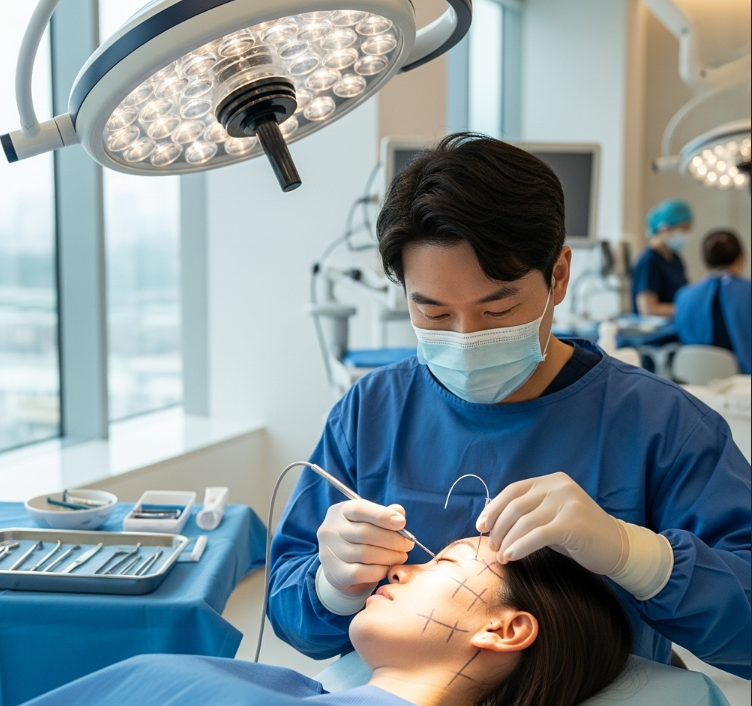Treatment Overview
The Cephalic Trim Technique is a rhinoplasty method that focuses on refining the nasal tip by carefully trimming the cephalic portion of the lower lateral (alar) cartilages. This technique is commonly used to correct a bulbous, wide, or droopy nasal tip while preserving enough cartilage to maintain structural support and proper nasal function. In Korea, surgeons use highly precise trimming methods combined with suture refinement to sculpt a slimmer, more defined, and natural-looking nasal tip.
Purpose & Benefits
The Cephalic Trim Technique aims to reshape and refine the nasal tip for better aesthetics and balance. Key benefits include:
- Reduction of bulbous or round nasal tips.
- Improved nasal tip definition and projection.
- Enhanced nasal symmetry and balance with facial features.
- Natural results that avoid an “overdone” or artificial look.
- Long-lasting refinement with preserved nasal support.
Ideal Candidates
This technique is best suited for individuals who:
- Have a bulbous or overly wide nasal tip.
- Feel their nose lacks definition or appears heavy at the lower third.
- Desire natural refinement without drastic structural changes.
- Are in good overall health with realistic expectations.
- May have undergone a previous rhinoplasty but require tip refinement.
Possible Risks & Complications
Though safe when performed by skilled Korean surgeons, potential risks may include:
- Swelling and bruising around the nasal tip.
- Temporary asymmetry during healing.
- Rare cases of over-resection leading to weak tip support.
- Mild scarring if external incisions are required.
- Prolonged sensitivity in the nasal tip area.
Surgical Techniques Used
In Korea, the Cephalic Trim Technique is refined with modern surgical methods to ensure subtle yet effective results. Common approaches include:
- Partial Cephalic Trim – selective trimming of excess cartilage while preserving structural integrity.
- Cartilage-Sparing Technique – leaving sufficient cartilage for support to avoid tip collapse.
- Suture Techniques (Tip Plasty) – using sutures to refine cartilage shape without over-removal.
- Hidden or Minimal Incisions – typically placed inside the nostrils for scar-free outcomes.
- Microsurgical Tools – for high precision and natural contouring.
Recovery & Aftercare
- Mild swelling and bruising typically last 1–2 weeks.
- Stitches (if used) are usually removed after 5–7 days.
- Most patients resume work or daily activities within 7–10 days.
- Final nasal tip definition may take 3–6 months as swelling gradually subsides.
- Korean clinics often provide scar care, anti-swelling therapy, and aftercare programs for faster recovery.
Results & Longevity
The Cephalic Trim Technique provides permanent improvement in nasal tip definition and proportion. Results appear natural and harmonious with other facial features, avoiding the risk of an overly sculpted or artificial nose. With advanced Korean methods, patients achieve subtle refinement that enhances beauty while maintaining nasal function and strength.
Treatment Process in Korea
Korea’s medical system is globally recognized for precise and natural-looking rhinoplasty outcomes. The treatment process generally follows these steps:
1. Consultation:
- Surgeons conduct a detailed analysis of nasal structure, cartilage strength, and facial balance.
- Digital imaging simulations may be used to preview results.
2. Pre-Surgery Care:
- Medical evaluations and surgical planning tailored to each patient’s anatomy.
- Pre-operative guidelines on fasting, medications, and recovery preparation.
3. Surgery:
- Performed under local anesthesia with sedation or general anesthesia.
- Procedure duration is usually 1–2 hours depending on complexity.
- Cartilage trimming and refinement are done with microsurgical precision.
4. Immediate Aftercare:
- Cooling treatments, anti-swelling injections, and medication for comfort.
- Patients monitored for several hours before discharge.
5. Follow-Up Care:
- Stitch removal within a week.
- 1–3 follow-up visits during recovery to monitor healing.
- Clinics may provide LED therapy, scar ointments, or ultrasound treatments.
6. Medical Tourism Support:
- International patients benefit from translator services, airport pickup, and hotel arrangements.
- Recovery-friendly care packages are often included.
Cost Range
The price of Cephalic Trim Rhinoplasty in Korea varies based on surgeon expertise, clinic reputation, and surgical complexity.
- General Price Range: ₩3,000,000 – ₩7,500,000 KRW (approx. $2,300 – $5,800 USD).
- Basic Packages Include: Consultation, anesthesia, surgery, and standard aftercare.
- Standard Packages Include: Scar management, swelling reduction therapy, and 2–3 follow-up sessions.
- Premium Packages Include: VIP recovery suites, private translators, extended skincare, and medical tourism services such as transport and accommodation.
Compared to Western countries, Korea offers highly competitive prices with more advanced surgical refinement, making it a leading choice for rhinoplasty patients worldwide.
Popular Clinics
- Banobagi Plastic Surgery Clinic (Seoul): Famous for natural and balanced nasal tip refinements.
- ID Hospital (Seoul): One of Korea’s largest plastic surgery centers specializing in advanced cartilage techniques.
- JW Plastic Surgery Clinic: Renowned for precision-based nasal tip surgery and cephalic trim procedures.
- View Plastic Surgery Clinic: Known for advanced scar-minimizing and cartilage-sparing approaches.
- MINE Plastic Surgery Clinic: Popular among international patients for customized nasal tip reshaping.




